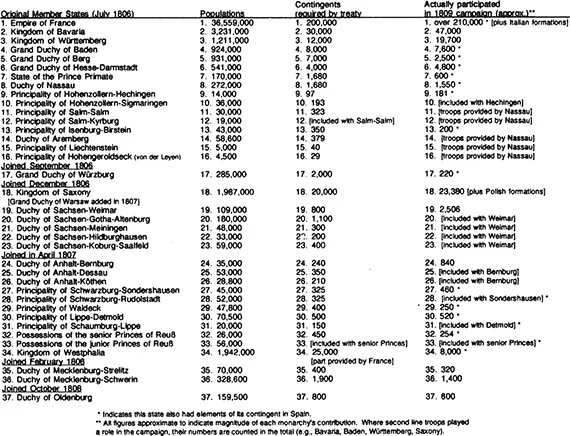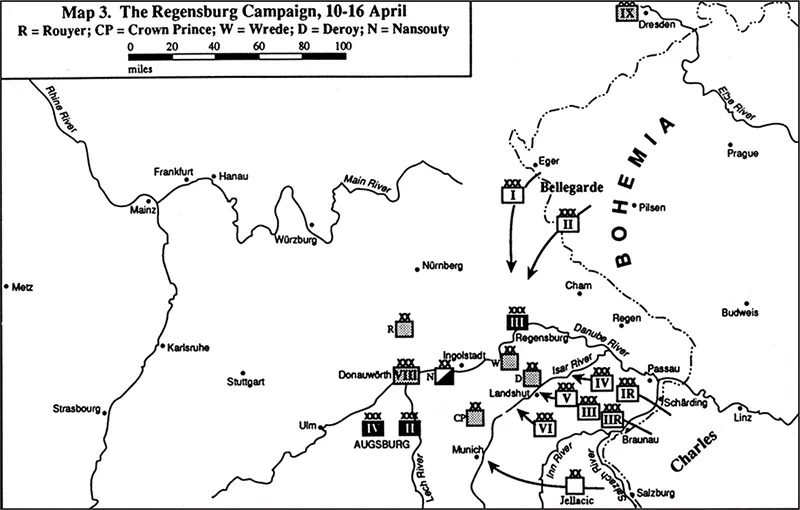![]()
PART I
THE CAMPAIGN IN THE DANUBE VALLEY
![]()
CHAPTER 1
Introduction: Clash of Empires
Early on the morning of 10 April 1809, shivering Bavarian cavalry pickets peered across the murky River Inn to see Austrian horsemen looming out of the fog on the far bank. They were the outriders of a huge host, 120,000 warriors of the Habsburg Empire whose twisting columns stretched along muddy roads twenty-five kilometres to the east. The Bavarian troopers did not wait to be accosted but spurred their mounts and sped west with news of the invasion. The War of 1809 had begun.
It was to be a clash of empires: ancient, reactionary Austrian and brash, revolutionary French, in no little part occasioned by the desire in both Vienna and Paris to control the destiny and resources of the multitude of states that made up central Germany. In 1809, however, those states, bound together in a political entity called the Confederation of the Rhine, were allies of Napoleon and their armies fought alongside French imperial eagles. Optimistic Habsburg courtiers might hope to rouse the Germans against their French Emperor, but they were to be bitterly disappointed: as Austrian pioneers struggled to bridge the broad Inn, 100,000 soldiers of the Confederation, Napoleon’s German allies, were burnishing their bayonets and preparing for war.
The Confederation of the Rhine
One of the principal political aims of Imperial France was the expansion of French influence in central Germany at the expense of the Austrian and Prussian monarchies. As French relations with Germany evolved, a number of schemes were developed to achieve this goal, but in their basic outlines all envisioned the establishment of a union of German states under French protection to replace the decrepit Holy Roman Empire and formalize Napoleon’s influence in Germany. In addition to extending French power across the Rhine, this plan was also intended to provide for the security of France itself. Given the violent nature of the age and the sustained opposition to Napoleon’s imperial pretensions, the safety of Napoleonic France was a key consideration in Paris and the German policy included an important military component that would serve to enhance French security in several ways. First, it would increase the French Empire’s military strength vis-à-vis its chief enemies. Not only would anti-French coalitions be deprived of key military resources, particularly the manpower provided under the aegis of the Holy Roman Empire, but it was hoped that these same resources would produce allied armies to augment France’s own forces in the field. Second, although the wars of the Revolutionary and Consular periods had pushed France’s borders to the Rhine, its numerous opponents to the east still stirred great concern in the French leadership. A belt of friendly German states east of the Rhine (a marche militaire), armed and trained by the victorious Grande Armée and integrated into its command structure, would create a comfortable buffer between the borders of la Patrie and its foes. Moreover, the creation of French dependencies in Germany would establish a firm foundation upon which France might build for the future, a framework through which French cultural, political, social, and above all, military norms might be infused into central Germany. The multitude of princes across the Rhine would thus identify their interests with those of Paris and abjure the threats and blandishments of Vienna, Berlin and St. Petersburg. Finally, the establishment of a series of loyal allied monarchies whose ruling families had deep roots in Europe’s aristocratic past would serve to legitimize the upstart Napoleonic dynasty in France and lay the groundwork for its continued existence.1
The first major step toward the implementation of Napoleon’s German policy came in 1805 when Bavaria, Württemberg and Baden signed bilateral agreements with France to supply auxiliary troops for the Grande Armée. The thunderous victory in that campaign gave the Emperor the power and prestige he needed to reshape Germany according to his own designs and established the preconditions for the further expansion of French hegemony over the ‘Third Germany,’ a rubric embracing the small states caught between Austria and Prussia. Work on the German union began in earnest that winter and culminated in July 1806 with the signature of the ’constitutional act’ of the Confederation of the Rhine (Rheinbund) by Napoleon and fifteen German sovereigns. Although broad in scope, this act in practice was basically a military alliance and most of its subsidiary provisions were never exercised or developed (e.g., legislative and judicial features). Each member state was thus required to supply a contingent of troops in case of war, the contingents varying in size according to the population of the state; Bavaria, for example, as the largest German member, agreed to put an army of 30,000 into the field, whereas the Prince von der Leyen was called upon to commit only 29 of his subjects. Napoleon, as the ‘Protector’ of the Confederation, obligated France to provide 200,000 men for the common defence.
The campaign of 1806–7 against Prussia and Russia saw the first test of the new alliance and most of the member nations eventually contributed troops to the Grande Armée. Some of the original signatories were able to mobilize their forces in time for the autumn fighting of 1806, but most found themselves unprepared for the pace of Napoleonic warfare and were unable to field effective contingents before the onset of winter. Winter and spring, however, saw a host of Rheinbund contingents in Prussia and Poland, principally involved in securing Napoleon’s long lines of communication or prosecuting the multitude of sieges against Prussian and Swedish fortresses holding out behind the main French army. Even the newest members of the Confederation, states like Saxony and the tiny Saxon Duchies that had been Prussian allies up to the Jena–Auerstädt débâcle, sent men to the front under French command, the Saxon cavalry being one of the few Allied contingents to participate in the grand battles of 1807. The campaign demonstrated the viability of the alliance and the value of the German troops (at least for rear area duties), but also highlighted some significant problems. Chief among these was the outdated structure of most of the German contingents and the resultant difficulty of integrating them into the modern French military machine. Over the next several years, therefore, most of Napoleon’s German allies, either independently or under French pressure, embarked upon programmes of rapid military reform and, over time, most of the Allied armies took on an increasingly French complexion.2
Table 1-1: Rheinbund States and Contingents
Napoleon’s juggernaut will dragged thousands of these German troops into the war with Spain starting in 1808 and only the largest Rheinbund states, such as Bavaria, Württemberg and Saxony, were able to evade the onerous responsibility of hurling their young men into the Iberian cauldron.3 When war with the Habsburg Empire came in the spring of 1809, many of the German contingents would thus be incomplete, large portions of their armies having been swallowed by the insatiable Spanish conflict. The requirements of that dreadful struggle, however, also occupied the majority of France’s veteran troops and Napoleon’s Rheinbund Allies would therefore assume an unprecedented first line role in the grand battles of the 1809 campaign against Austria.
Thunder on the Danube – The 1809 War with Austria
For many in Austria, the spring of 1809 seemed to offer a clear opportunity to reassert Habsburg influence in Germany and avenge the humiliations Napoleon had inflicted on the ancient dynasty in 1797, 1800 and 1805. With most of the French Army and the dreaded Emperor of Battles himself off in the wilds of Spain, bogged down in a guerrilla quagmire, the military situation seemed propitious.4 The political landscape appeared equally promising. In Germany, a host of patriots more zealous than realistic were anxious to persuade Vienna that the entire Teutonic population was ready to rise up and throw off the Napoleonic ‘yoke’. The Tyrol, too, chafing under Bavarian rule, was restive and leaders of its fiercely independent inhabitants were already in contact with Austrian agents. To the east, quiet assurances from St. Petersburg indicated that the huge Russian Army would intervene slowly, if at all, should war come (despite the promises given to Napoleon by the Tsar at Erfurt the previous autumn). In Vienna, then, the war party slowly gained dominance and by February 1809 the lumbering Habsburg military machine, over the objections of its generalissimo, the Archduke Charles, was irrevocably committed to war.
APRIL: The War Opens and the Tide Turns
Austrian strategy in 1809 was offensive and an army of invasion was committed to each area where the Habsburg Empire bordered on the territory of France and its vassal states. The main effort would be made in the Danube valley, where Archduke Charles would invade Napoleon’s largest German ally, Bavaria, at the head of eight army corps (I to VI, plus I and II Reserve). Several strategic options for the employment of this large host were considered, but the Habsburg military pundits eventually settled on a plan which sent six of the Main Army’s (Hauptarmee) corps across the River Inn in the general direction of Landshut in the hopes of catching the French by surprise and destroying their scattered units one by one. In the meantime, the remaining two corps (I and II under the overall command of General der Kavallerie Graf Bellegarde) would debouch from Bohemia and approach the Danube from the north to pin French forces in that direction. Secondary efforts were to be mounted in Poland (VII Corps) and Italy (VIII and IX Corps), while a small detachment pushed into the vales of the Tyrol to support that province’s insurrection. Meanwhile, it was hoped that the Austrian declaration of war would rouse the peoples of Germany to a nationalistic struggle against the French and thereby force Napoleon to cope with a major uprising in his rear area. The war would thus span Europe from the Baltic to the Adriatic and from the Rhine to the Vistula with five principal theatres of operations: the Danube valley; the Tyrol and the Vorarlberg; the southern front (Italy, Dalmatia, Hungary); north-central Germany; and Poland.
Table 1-2: Austrian Forces in the Danube Valley (April)
On the French side, the situation was somewhat tense but not dire. Napoleon had long recognized Austria’s belligerent intentions and even while campaigning in Spain, he had taken steps to concentrate the French troops dispersed in garrisons all across the face of Germany. With a large proportion of his men still tied down south of the Pyrenees, however, the Emperor realized that he would have to lean heavily on his German allies in any conflict with the Habsburgs. On 15 January, he had therefore sent a series of letters to the Rheinbund monarchs, directing them to put their contingents on a war footing and await further orders. Two days later, he left Spain for Paris. As a result of these orders, a large army was assembling in southern Germany by early April: Davout’s huge III Corps was moving on Regensburg (Ratisbonne), Massena was slowly collecting a two-corps force along the River Lech (his own IV Corps and II Corps temporarily under Général de Division oudinot), and the Guard was making the uncomfortable journey from Spain in hurriedly requisitioned wagons.5 in ad...





